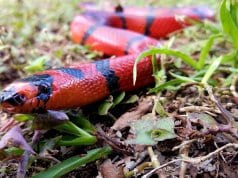Mimicry is an adaptation in which one animal evolves to look like another animal. Many animals use mimicry to avoid predators, but some predators use mimicry to obtain food. Some parasites even use mimicry to help them escape detection.
Mimicry is a very effective adaptation, and it is crucial to the survival of many species. We’ll explain the basics of mimicry below and share a few interesting examples.
Models and Mimics: Important Terminology
Scientists use the terms mimic and model to describe the relationships between similar-looking species.
Mimicry occurs in a number of different ways, but it usually involves three species.

The first animal, known as the model, is usually distasteful or dangerous to predators. The second animal, the mimic, is harmless but looks or behaves like the model. The third participant, called the dupe, is the animal who mistakes the mimic for the model.
For example, some butterflies – such as the Ismenius tiger – are distasteful. This causes birds to avoid eating them. But other butterflies, such as the tiger leafwing butterfly, don’t taste bad to birds. This means they’d normally be in danger of being eaten.
However, tiger leafwing butterflies have evolved to resemble Ismenius tiger butterflies. This makes them safer, as birds mistake them for the bad-tasting butterflies. This causes the birds to ignore them entirely.
In this example, the Ismenius tiger butterfly is the model, the tiger leafwing butterfly is the mimic, and the birds who would normally eat them are the dupes.
Different Types of Mimicry
Mimicry occurs in several different forms, depending on the mimic’s needs.
Animals use several different types of mimicry for protection. The tiger leafwing butterflies discussed above exhibit Batesian mimicry. This occurs when an unprotected animal defends itself by resembling a dangerous or distasteful animal.

Mullerian mimicry occurs when two different species look alike. This benefits both animals, as predators will typically avoid them all. This type of mimicry is common to many groups of butterflies. For example, monarch and viceroy butterflies often resemble each other. They are both distasteful to birds, so birds tend to avoid both species.
Aggressive mimicry is another pattern that occurs when a parasite or predator mimics the species it is trying to capture. Some fireflies, for example, produce lights that resemble the lights other firefly species produce. When an unsuspecting male approaches the mimic for mating purposes, the mimic quickly grabs and eats the dupe.
Examples of Mimicry in Nature
There are thousands of mimics in the world, but these are a few of the most notable.
Biologists have observed mimicry in a variety of habitats. We’ll describe a few particularly interesting examples below.

- Several kingsnakes look just like coral snakes. Kingsnakes are harmless, so they are vulnerable to predators. But coral snakes are venomous animals, who can defend themselves well. By mimicking coral snakes, kingsnakes are able to deter predators.
- The zone-tailed hawk mimics turkey vultures to catch prey. Vultures are rarely dangerous to healthy animals, as they feed on dead or weak animals. This leads most animals to ignore vultures flying overhead. But the zone-tailed hawk is a predator that does eat healthy animals. By blending in with vultures, zone-tailed hawks can catch their prey by surprise.
- Alligator snapping turtles use their tongues to capture fish. When hungry, alligator snapping turtles rest on the bottom of their lake or river. They’ll then open their mouth and wiggle their tongue. This makes their tongue look like a worm, which attract fish. When one comes close, the turtle snaps its jaws closed and captures the fish.
- Young copperheads wiggle their tails to attract prey. Baby copperheads have yellow tails. When hungry, they’ll hide in the leaf litter and move their tails like a caterpillar. When a nearby frog sees this, it’ll move toward the snake. But once it gets close, the snake will strike out and capture the amphibian.
- Some animals mimic themselves as a form of protection. Many insects, for example, have large eyespots on their backs. These eyespots confuse predators into thinking that their prey is watching them. Most predators avoid attacking animals that are watching them, so the insects remain safe from predators.

As you can see, mimicry is a very effective and common survival strategy used in the natural world. Almost every habitat and ecosystem on earth is home to several mimics. You can even see some mimics in your own backyard.
Note that while some mimics look exactly like the models they resemble, others only bear a slight resemblance. This is especially true of animals that use mimicry to avoid predators with poor eyesight.
Some animals will even act like other animals to fool predators. For example, the mimic octopus will hold its body in ways that make it look like a completely different animal. Sometimes, they’ll flatten their body and mimic a dangerous sting ray. At other times, they’ll move their arms in a way that makes them look like a deadly sea snake.
You should also note that not all mimicry is based on appearance. Some animals mimic the sounds other animals create. Mockingbirds, for example, are famous for mimicking the calls of other birds.
We’ve explained a few of the most interesting examples of mimicry above. However, there are countless other species that also use mimicry to survive. Can you think of any other examples of mimicry in the animal kingdom? Share your examples with us in the comments below.














![Red Angus Closeup of a beautiful Red Angus cowPhoto by: U.S. Department of Agriculture [pubic domain]https://creativecommons.org/licenses/by/2.0/](https://animals.net/wp-content/uploads/2020/03/Red-Angus-4-100x75.jpg)

